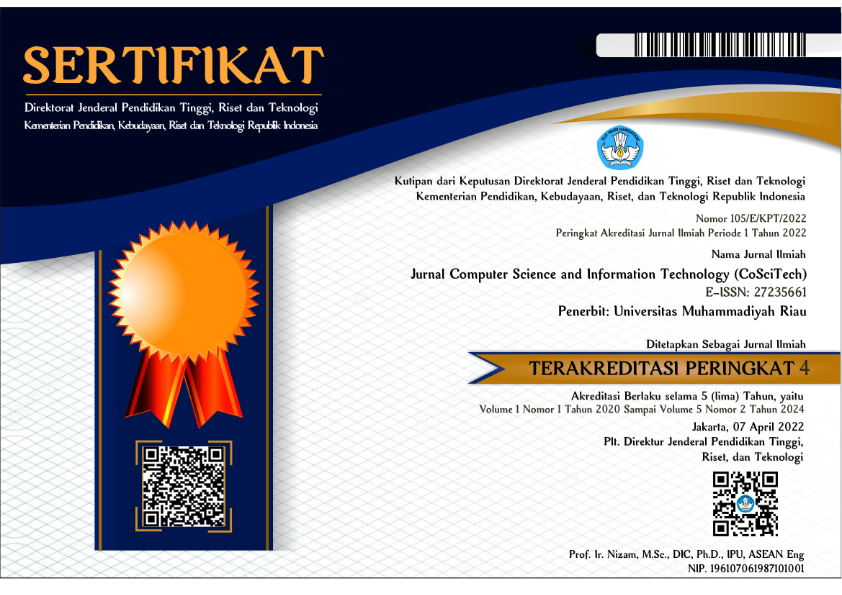AdaBoost Classification for Predicting Residential Habitation Status in Mount Merapi Post-Eruption Rehabilitation
DOI:
 https://doi.org/10.37859/coscitech.v4i2.5141
https://doi.org/10.37859/coscitech.v4i2.5141
Abstract
This research paper explores the use of the AdaBoost algorithm for predicting residential habitation status in the aftermath of the Mount Merapi eruption. Using a dataset from the Rehabilitation and Reconstruction Task Force, with 2516 instances and 11 attributes, the AdaBoost model was trained and evaluated. The model demonstrated a robust performance with an accuracy of 92%, though it struggled with correctly identifying all 'No Habited' instances. These findings underscore the potential of machine learning algorithms in disaster management, particularly in optimizing resource allocation and expediting recovery times. Future research should aim to improve the model's performance on imbalanced datasets and explore the incorporation of temporal dimensions for more dynamic and accurate predictions.
Downloads
References
[2] A. K. M. Kablan, K. Dongo, G. Fokou, and M. Coulibaly, “Assessing population perception and socioeconomic impact related to flood episodes in urban Côte d’Ivoire,” Int. J. Bio. Chem. Sci, vol. 13, no. 4, p. 2210, Nov. 2019, doi: 10.4314/ijbcs.v13i4.26.
[3] A. Santoso, J. Parung, D. N. Prayogo, A. Lolita, and Department of Industrial Engineering, University of Surabaya Raya Kalirungkut, Surabaya 60293, Indonesia, “Designing an Indonesian Disaster Management Information System with Local Characteristics: A Case Study of Mount Merapi,” JDR, vol. 16, no. 4, pp. 765–777, Jun. 2021, doi: 10.20965/jdr.2021.p0765.
[4] A. Flora, D. Cardone, M. Vona, and G. Perrone, “A Simplified Approach for the Seismic Loss Assessment of RC Buildings at Urban Scale: The Case Study of Potenza (Italy),” Buildings, vol. 11, no. 4, 2021, doi: 10.3390/buildings11040142.
[5] F. Chasanah and H. Sakakibara, “Implication of Mutual Assistance Evacuation Model to Reduce the Volcanic Risk for Vulnerable Society: Insight from Mount Merapi, Indonesia,” Sustainability, vol. 14, no. 13, 2022, doi: 10.3390/su14138110.
[6] V. W. Astuti and R. Rimawati, “Kelud Community Activities in Disaster Management,” jqph, vol. 5, no. 1, pp. 339–343, Nov. 2021, doi: 10.30994/jqph.v5i1.270.
[7] M. Filipovič Hrast, R. Sendi, and B. Kerbler, “Housing Choices of Older People: Staying or Moving in the Case of High Care Needs,” Sustainability, vol. 12, no. 7, 2020, doi: 10.3390/su12072888.
[8] T. Kim and W.-D. Lee, “Review on Applications of Machine Learning in Coastal and Ocean Engineering,” J. Ocean Eng. Technol., vol. 36, no. 3, pp. 194–210, Jun. 2022, doi: 10.26748/KSOE.2022.007.
[9] N. Wijaya, “Evaluation of Naïve Bayes and Chi-Square performance for Classification of Occupancy House,” International Journal of Informatics and Computation; Vol 1 No 2 (2019): International Journal of Informatics and ComputationDO - 10.35842/ijicom.v1i2.20, Feb. 2020, [Online]. Available: https://ijicom.respati.ac.id/index.php/ijicom/article/view/20
[10] N. Wijaya, J. Aryanto, K. Kasmawaru, and A. F. Rachman, “Implementation of KNN Algorithm for Occupancy Classification of Rehabilitation Houses,” International Journal of Informatics and Computation; Vol 4 No 2 (2022): International Journal of Informatics and ComputationDO - 10.35842/ijicom.v4i2.36, Dec. 2022, [Online]. Available: https://ijicom.respati.ac.id/index.php/ijicom/article/view/36
[11] J. Zhou, X. Xu, X. Huo, and Y. Li, “Forecasting Models for Wind Power Using Extreme-Point Symmetric Mode Decomposition and Artificial Neural Networks,” Sustainability, vol. 11, no. 3, 2019, doi: 10.3390/su11030650.
[12] S. Jagdale and M. Shah, “Extending the Classifier Algorithms in Machine Learning to Improve the Performance in Spoken Language Understanding Systems Under Deficient Training Data,” Advances in Science, Technology and Engineering Systems Journal, vol. 5, no. 6, pp. 464–471, 2020, doi: 10.25046/aj050655.
[13] N. Chen, “House Price Prediction Model of Zhaoqing City Based on Correlation Analysis and Multiple Linear Regression Analysis,” Wireless Communications and Mobile Computing, vol. 2022, p. 9590704, May 2022, doi: 10.1155/2022/9590704.
[14] A. Burger, T. Oz, W. G. Kennedy, and A. T. Crooks, “Computational Social Science of Disasters: Opportunities and Challenges,” Future Internet, vol. 11, no. 5, 2019, doi: 10.3390/fi11050103.
[15] S. Chen et al., “Physical-Layer Channel Authentication for 5G via Machine Learning Algorithm,” Wireless Communications and Mobile Computing, vol. 2018, p. 6039878, Oct. 2018, doi: 10.1155/2018/6039878.
[16] S. Saravi, R. Kalawsky, D. Joannou, M. Rivas Casado, G. Fu, and F. Meng, “Use of Artificial Intelligence to Improve Resilience and Preparedness Against Adverse Flood Events,” Water, vol. 11, no. 5, 2019, doi: 10.3390/w11050973.
[17] G. Luo, M. D. Johnson, F. L. Nkoy, S. He, and B. L. Stone, “Automatically Explaining Machine Learning Prediction Results on Asthma Hospital Visits in Patients With Asthma: Secondary Analysis,” JMIR Med Inform, vol. 8, no. 12, p. e21965, Dec. 2020, doi: 10.2196/21965.
[18] A. Abdurrasyid, I. Indrianto, and M. N. I. Susanti, “Face detection and global positioning system on a walking aid for blind people,” Bulletin of Electrical Engineering and Informatics; Vol 11, No 3: June 2022DO - 10.11591/eei.v11i3.3429, Jun. 2022, [Online]. Available: https://beei.org/index.php/EEI/article/view/3429














